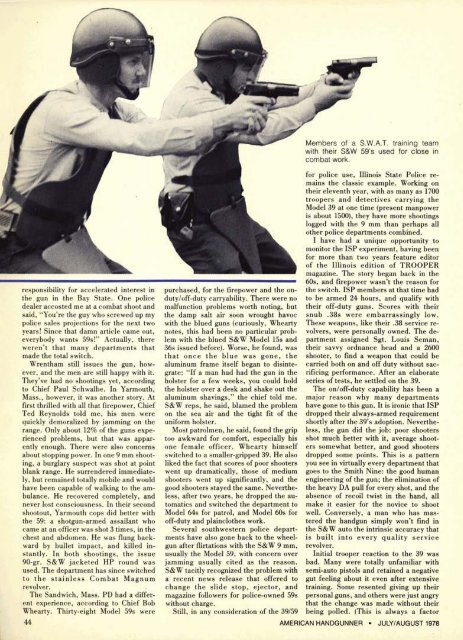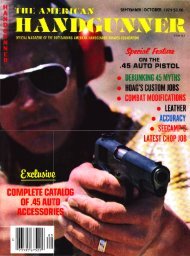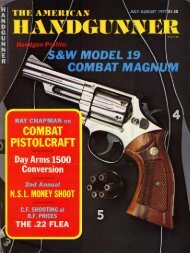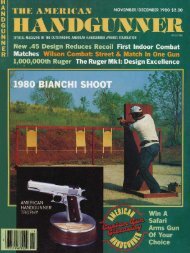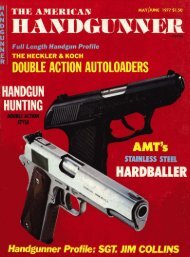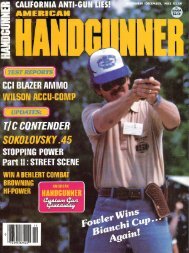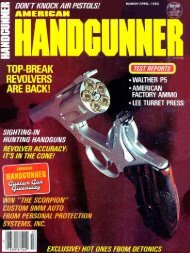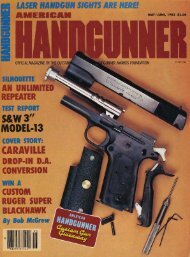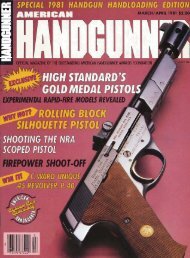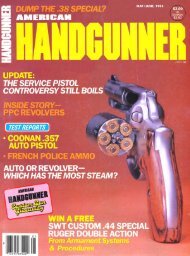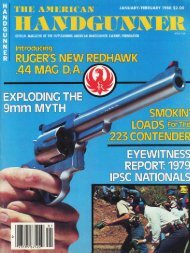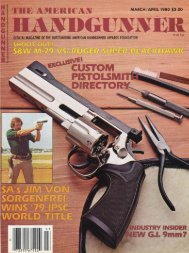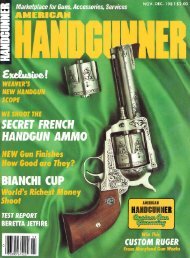July/August 1978 - American Handgunner
July/August 1978 - American Handgunner
July/August 1978 - American Handgunner
Create successful ePaper yourself
Turn your PDF publications into a flip-book with our unique Google optimized e-Paper software.
,-- Members of a S.W.A.T. training teamwith their S&W 59's used for close incombat work.responsibility for accelerated interest in'the gun in the Bay State. One policedealer accosted me at a combat shoot andsaid, "You're the guy who screwed up mypolice sales projections for the next twoyears! Since that damn article came out,everybody wants 59s!" Actually, thereweren't that many departments thatmade the total switch.Wrentham still issues the gun, however,and the men are still happy with it.They've had no shootings yet, accordingto Chief Paul Schwalbe. In Yarmouth.Mass., however, it was another story. Atfirst thrilled with all that firepower, ChiefTed Reynolds told me, his men werequickly demoralized by jamming on therange. Only about 12% of the guns experiencedproblems, but that was apparentlyenough. There were also concernsabout stopping power. In one 9 mm shooting,a burglary suspect was shot at pointblank range. He surrendered immediately,but remained totally mobile and wouldhave been capable of walking to the ambulance.He recovered completely, andnever lost consciousness. In their secondshootout, Yarmouth cops did better withthe 59: a shotgun-armed assailant whocame at an officer was shot 3 times, in thechest and abdomen. He was flung backwardby bullet impact, and killed instantly.In both shootings, the issue90-gr. S&W jacketed HP round wasused. The department has since switchedto the stainless Combat Magnumrevolver.The Sandwich, Mass. PD had a differentexperience, according to Chief BobWhearty. Thirty-eight Model 59s wereIk^L,purchased, for the firepuwoi the ~ n-dutyloff-duty carryability. There were nomalfunction nroblems worth notine. but -,the damp salt air soon wrought havocwith the blued guns (curiously, Wheartynotes, this had been no particular problemwith the blued S&W Model 15s and36s issued before). Worse, he found, wasthat once the blue was gone, thealuminum frame itself began to disintegrate:"If a man had had the gun in theholster for a few weeks, you could holdthe holster over a desk and shake out thealuminum shavings," the chief told me.S&W reps, he said, blamed the problemon the sea air and the tight fit of theuniform holster.Most patrolmen, he said, found the griptoo awkward for comfort, especially hisone female officer. Whearty himselfswitched to a smaller-gripped 39. He alsoliked the fact that scores of poor shooterswent up dramatically, those of mediumshooters went up significantly, and thegood shooters stayed the same. Nevertheless,after two years, he dropped the automaticsand switched the department toModel 64s for patrol, and Model 60s foroff-duty and plainclothes work.Several southwestern police departmentshave also gone back to the wheelgunafter flirtations with the S&W 9 mm,usually the Model 59, with concern overjamming usually cited as the reason.S&W tacitly recognized the problem witha recent news release that offered tochange the slide stop, ejector, andmagazine followers for police-owned 59swithout charge.Still, in any consideration of the 39159for police use, Illinois State Police remainsthe classic example. Working ontheir eleventh year, with as many as 1700troopers and detectives carrying theModel 39 at one time (present manpoweris about 1500), they have more shootingslogged with the 9 mm than perhaps allother police departments combined.I have had a unique opportunity tomonitor the ISP experiment, having beenfor more than two years featureeditorof the Illinois edition of TROOPERmagazine. The story began back in the60s, and firepower wasn't the reason forthe switch. ISP members at that time hadto be armed 24 hours, and qualify withtheir off-duty guns. Scores with theirsnub .38s were embarrassingly low.These weapons, like their .38 service revolvers,were personally owned. The departmentassigned Sgt. Louis Seman,their savvy ordnance head and a 2600shooter, to find a weapon that could becarried both on and off duty without sacrificingperformance. After an elaborateseries of tests, he settled on the 39.The onloff-duty capability has been amajor reason why many departmentshave gone to this gun. It is ironic that ISPdropped their always-armed requirementshortly after the 39's adoption. Nevertheless,the gun did the job: poor shootersshot much better with it, average shooterssomewhat better, and good shootersdropped some points. This is a patternyou see in virtually every department thatgoes to the Smith Nine: the good humanengineering of the gun; the elimination ofthe heavy DA pull for every shot, and theabsence of recoil twist in the hand, allmake it easier for the novice to shootwell. Conversely, a man who has masteredthe handgun simply won't find inthe S&W auto the intrinsic accuracy thatis built into every quality servicerevolver.Initial trooper reaction to the 39 wasbad. Many were totally unfamiliar withsemi-auto pistols and retained a negativegut feeling about it even after extensivetraining. Some resented giving up theirpersonal guns, and others were just angrythat the change was made without theirbeing polled. (This is always a factorAMERIC ;AN HANDGUNNER JULYIAUGUST <strong>1978</strong>


